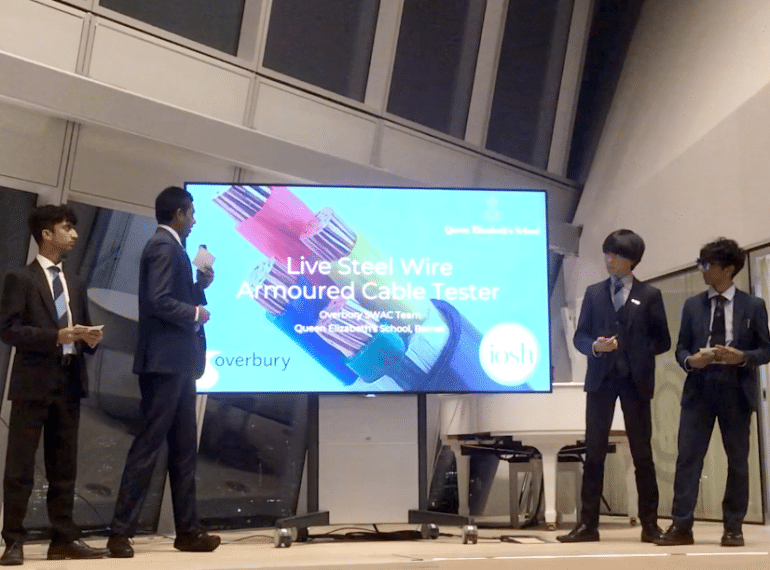
Two Sixth Form teams devised innovative engineering solutions to workplace safety challenges and successfully presented them to the world’s largest health & safety organisation.
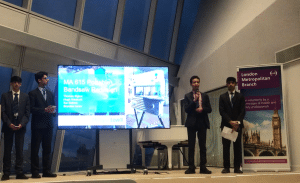 The presentations were part of this year’s QE submissions under the Engineering Excellence Scheme (EES). The Year 12 boys are hoping to follow in the illustrious footsteps of other QE EES teams of recent years whose inventions under the Engineering Project Challenges initiative have achieved regional and national success.
The presentations were part of this year’s QE submissions under the Engineering Excellence Scheme (EES). The Year 12 boys are hoping to follow in the illustrious footsteps of other QE EES teams of recent years whose inventions under the Engineering Project Challenges initiative have achieved regional and national success.
They gave their presentations to members of the Institution of Occupational Safety and Health (IOSH, a UK-based global chartered body for health & safety professionals), just before the COVID-19 social distancing measures were put in place The venue was UBM’s centre close to Blackfriars Bridge in London.
QE’s Head of Technology, Michael Noonan, said: “The teams had been set engineering challenges to work on by two major office fit-out companies, Morgan Lovell and Overbury. QE has achieved brilliant things in recent years in this initiative, and this year’s boys did not disappoint: after six months’ work, they came up with carefully thought-through solutions based on sound engineering principles. They then presented these ideas fluently and with some confidence to the assembled IOSH members and other guests.”
The Engineering Project Challenges started off with a project tour and introduction to site conditions and equipment by industry sponsors Overbury and Morgan Lovell, both part of the Morgan Sindall construction group.
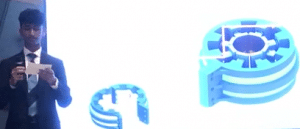 After seeing demonstrations of equipment and operatives at work, the boys were charged with finding innovative solutions to two specific problems.
After seeing demonstrations of equipment and operatives at work, the boys were charged with finding innovative solutions to two specific problems.
The Overbury team had the challenge of creating an easy-to-use, hand-held, non-intrusive tool to check if an electrical steel wired armoured cable is live. The team members are: Enoch Hitchcock, Yai Sagolsem, Pranay Surana and Ukendar Vadivel.
The Morgan Lovell team were tasked with making health & safety improvements to a portable band saw, including blade protection and extraction of dust, to ensure that users could cut material both safely and quickly. The blade protection had to be designed in such a way that it could be retrofitted to existing machines. The team comprises: Brandon Ionev, Thomas Mgbor, Kai Sethna and Hugh Westcott.
Both teams were required to undertake analysis through extensive research to find the best practical and innovative engineering methods, and to solve these challenges without involving excess manufacturing costs. They were assisted by their industry mentor, representing Overbury and Morgan Lovell, Health Safety & Wellbeing Manager Alex Wood.
In their 15-minute presentation, team leader Ukendar and his fellow team members working on the project with Overbury explained their solution – a device featuring a hinged clamp and a handle with red and green LEDs to indicate whether the cable being worked on was live or not. In a question-and-answer session with members, they confirmed that the device could readily be manufactured to accommodate different sizes of steel wired armoured cable.
The Morgan Lovell team explained that their guard could be easily and quickly fitted to a band saw in a busy workplace environment. Questioned as to why they had made it in opaque materials, they confirmed that this was just for the prototype and that production models could be made in transparent ABS plastic.
Overall, the objective of the challenges is to introduce young people to careers in the construction and building fit-out and office fit-out industries and to help them apply what they have learnt about STEM (Science, Technology, Engineering and Mathematics) in the classroom into the real world.
The two teams will be hoping to emulate the successes of predecessors, including a 2018 QE team who devised a stair-climbing robot for transporting large sheets of material up staircases on construction sites. This was Highly Commended in the Contribution to the Business Award at the Celebration and Assessment Day of the Engineering Excellence Scheme (EES). And in the year before that, a QE project for the EES – a helmet which warned construction workers when workplace noise was exceeding safe levels – was among the national engineering prize-winners at The Big Bang, the UK Young Scientists & Engineers Fair.

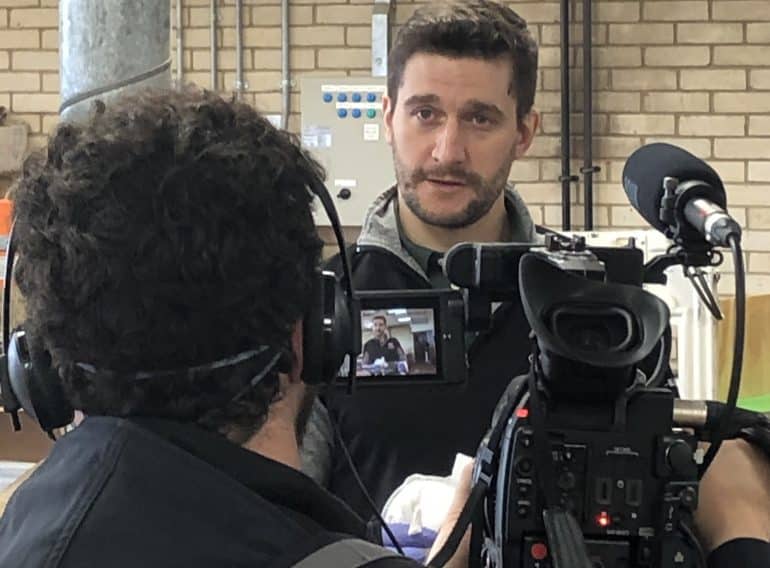
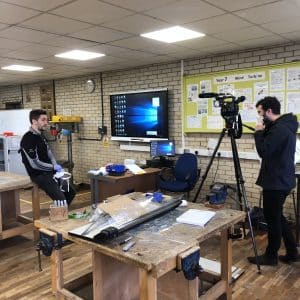 “We have material, we have manufacturing facilities, we have knowledge and skill and we have the ability to create sanitary environments, so we are putting our skill and all of our facilities into solving [the PPE shortage] problem right now,” Mr Noonan told the team from The Times when they visited to film him at work (while maintaining safe social distancing).
“We have material, we have manufacturing facilities, we have knowledge and skill and we have the ability to create sanitary environments, so we are putting our skill and all of our facilities into solving [the PPE shortage] problem right now,” Mr Noonan told the team from The Times when they visited to film him at work (while maintaining safe social distancing).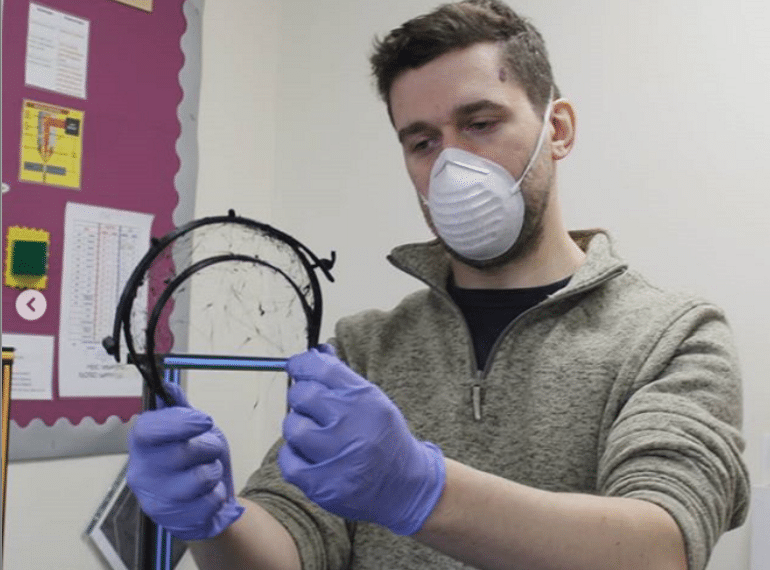
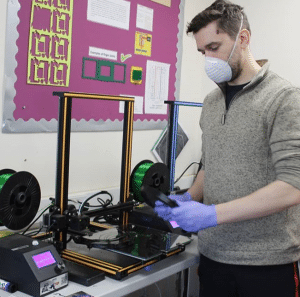 In addition to coming into School twice a day to set up and run the machines, which would otherwise be idle, Mr Noonan is also co-ordinating 3D-printing efforts among volunteers from schools and individuals. The face shields and ventilator components are being produced for hospitals, GP surgeries and social care organisations.
In addition to coming into School twice a day to set up and run the machines, which would otherwise be idle, Mr Noonan is also co-ordinating 3D-printing efforts among volunteers from schools and individuals. The face shields and ventilator components are being produced for hospitals, GP surgeries and social care organisations. Welsh engineer David Sims initially came up with the idea of using his home 3D printer to make the shields after a discussion on Facebook with others around the world working on designs to help health workers. He was quickly contacted by NHS doctors from around the country who placed orders with him.
Welsh engineer David Sims initially came up with the idea of using his home 3D printer to make the shields after a discussion on Facebook with others around the world working on designs to help health workers. He was quickly contacted by NHS doctors from around the country who placed orders with him.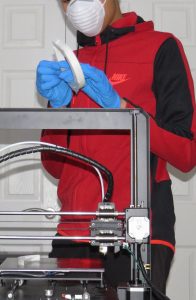 “I was one of the first London people involved, so I just kind of fell into coordinating,” Mr Noonan added.
“I was one of the first London people involved, so I just kind of fell into coordinating,” Mr Noonan added.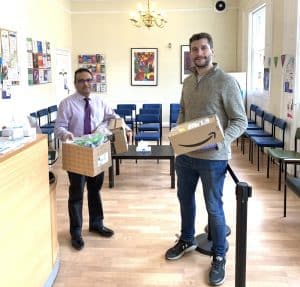 UPDATE: 3rd April 2020. Mr Noonan has now donated the first consignment of face shields to the NHS locally, handing over the supplies to Dr Ahmer Farooqi, Director, Barnet Federated GPs (and a QE dad), who have posted a
UPDATE: 3rd April 2020. Mr Noonan has now donated the first consignment of face shields to the NHS locally, handing over the supplies to Dr Ahmer Farooqi, Director, Barnet Federated GPs (and a QE dad), who have posted a 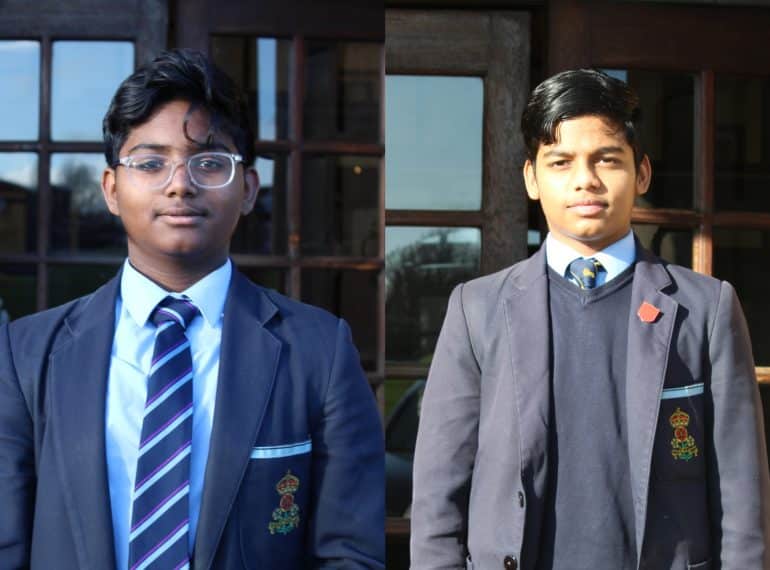
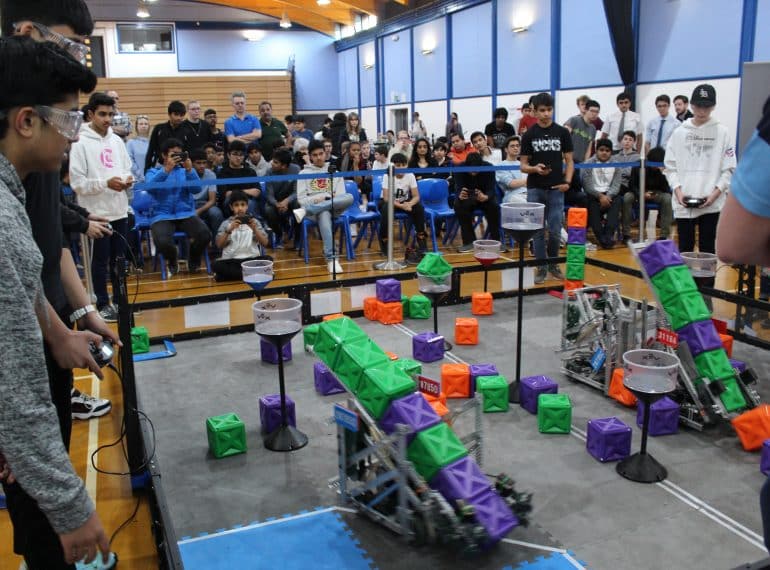
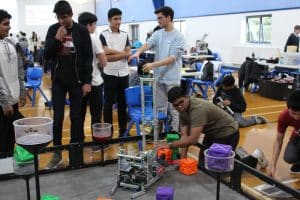 QE entered four teams: HYBRID, comprising Year 12 pupils, and SYNAPSE, ECLIPSE and Technogear, whose team members are all in Year 10 and were thus the youngest competitors in this age group.
QE entered four teams: HYBRID, comprising Year 12 pupils, and SYNAPSE, ECLIPSE and Technogear, whose team members are all in Year 10 and were thus the youngest competitors in this age group.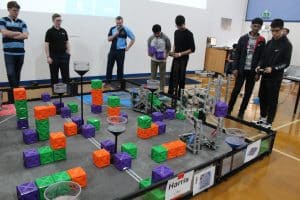 And Mark Jones, also a Design/Excellence judge said “The standard of the design and build was very good, especially with those teams that are new to the VEX and VRC competitions. The teams were knowledgeable about their robots and the processes that they had been through.”
And Mark Jones, also a Design/Excellence judge said “The standard of the design and build was very good, especially with those teams that are new to the VEX and VRC competitions. The teams were knowledgeable about their robots and the processes that they had been through.”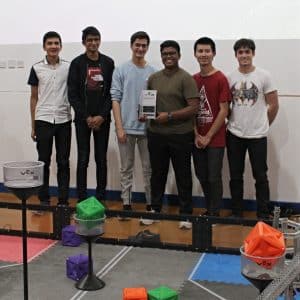 In the final round, the action started in an unexpected way, when the number one-ranked team changed their autonomous routine. This tactic proved crucial, as the scramble for cubes ended in a flurry of scoring, de-scoring and stacking of cubes in protected zones. Ultimately, the highly offensive tactics of the higher ranked alliance prevailed, with QE-JWS winning out with a score line of 65-20. The audience recognised the efforts of the teams in reaching the pinnacle of the competition, as did the judging panels.
In the final round, the action started in an unexpected way, when the number one-ranked team changed their autonomous routine. This tactic proved crucial, as the scramble for cubes ended in a flurry of scoring, de-scoring and stacking of cubes in protected zones. Ultimately, the highly offensive tactics of the higher ranked alliance prevailed, with QE-JWS winning out with a score line of 65-20. The audience recognised the efforts of the teams in reaching the pinnacle of the competition, as did the judging panels. “Great credit is due to their drivers and designers, as well as their programmers for an autonomous routine which proved effective throughout,” said Mr Noonan.
“Great credit is due to their drivers and designers, as well as their programmers for an autonomous routine which proved effective throughout,” said Mr Noonan.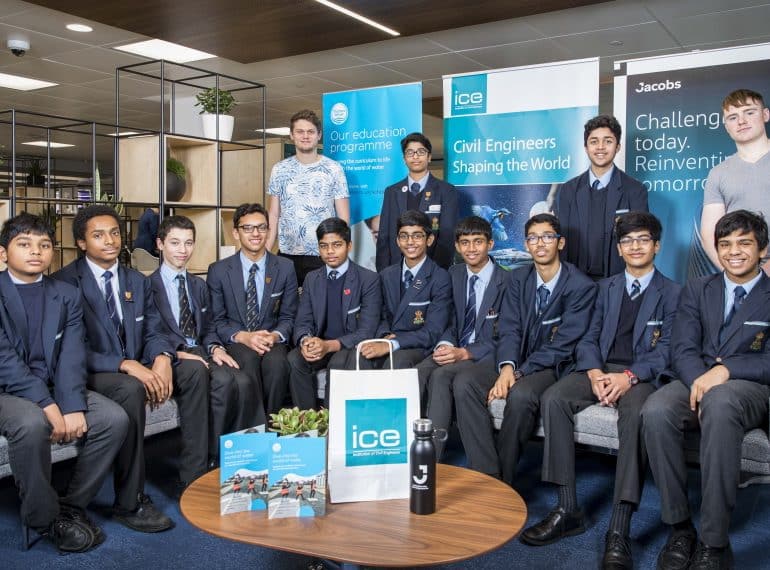
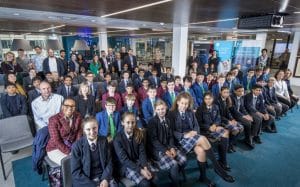 Congratulating the finalists, ICE London Director Jonathan Baggs said: “The #ICanEngineer Competition has shown that our schools are full of budding engineers and innovators.
Congratulating the finalists, ICE London Director Jonathan Baggs said: “The #ICanEngineer Competition has shown that our schools are full of budding engineers and innovators.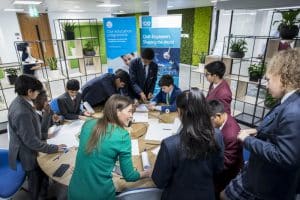 Now in its fourth year, the #ICanEngineer competition, organised by the ICE London Graduates and Students committee, has continued to grow. This year, more than 50 pupils competed from schools across the London boroughs.
Now in its fourth year, the #ICanEngineer competition, organised by the ICE London Graduates and Students committee, has continued to grow. This year, more than 50 pupils competed from schools across the London boroughs.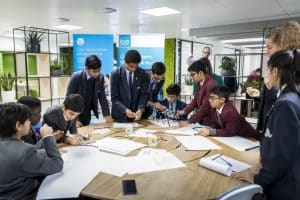 “Personally, I was very impressed with their submissions,” said Karan. “I would like to pass on my congratulations to everyone involved, especially as QE won both the sustainability prize as well as the overall competition. I look forward to seeing the trophy in the School the next time I’m around.”
“Personally, I was very impressed with their submissions,” said Karan. “I would like to pass on my congratulations to everyone involved, especially as QE won both the sustainability prize as well as the overall competition. I look forward to seeing the trophy in the School the next time I’m around.”